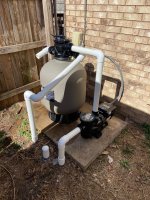Bought a house and paid a pool builder to remodel our 1980s pool in Dec 2021. They installed the pool pump (Jandy VS Flopro 1.65) and pool filter (Jandy SFTM24-2.0) in Feb 2022 before they closed their remodeling part of the business. (They did not resurface our gunite pool. Just cleaned it.) We then paid a licensed electrician to connect the electrical to the pool pump and filter in Oct 2022. We finally got the pool resurfaced and open our pool this year. Pool pump stopped working, and we found water in the electrical box and the pool pump control board housing. The circuit board within the pool pump exploded from all the water. It seems like water got into the new gray junction box and used the conduit as a path straight into the control board housing. Will anyone be able to tell me what went wrong, so I will know how to proceed?
First photo was after the installation of the pool pump and filter before the electrician came. Second photo was after the electrician wired in the new pump.


First photo was after the installation of the pool pump and filter before the electrician came. Second photo was after the electrician wired in the new pump.










 Perhaps the OP can make a claim to get that thing exchanged.
Perhaps the OP can make a claim to get that thing exchanged.

